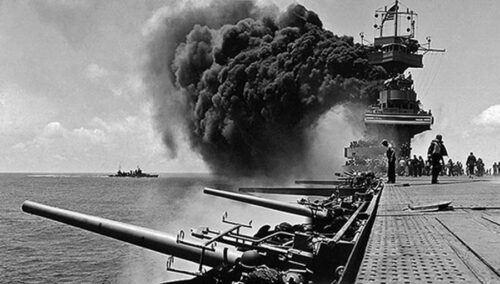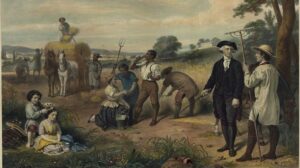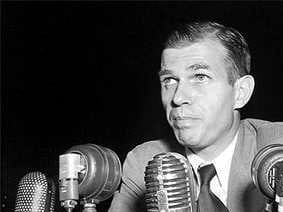
Historical Reads: The Battle of Midway
I am interested in a variety of topics and eras in history, although I am drawn mostly to memoirs and analytical military history. Perhaps that seems like a contradiction, given that one tends toward the personal while the other the technical, but that’s me as a reader. I especially enjoy reading different genres of writing on a single event or idea, as I recently did to learn about the Battle of Midway.
Anticipating the release of Roland Emmerich’s movie Midway last November, I decided that I needed to bone up on the battle, about which I knew in mostly general terms. I have had the good fortune of running TAH programs on board the USS Midway in San Diego since Spring 2019, and they have a great used bookstore on board – a delightfully cramped room off of the hangar deck, packed with quality used books, maps, and other materials, most of which are related to the battle after which the ship was named. If you ever visit the ship, make sure to find it and take a look around – it’s on the port side of the ship, near the bow, inside the hangar deck. If those nautical terms don’t mean anything to you, consider this your opportunity to learn something new.
In any case, I picked up Miracle at Midway, by Gordon W. Prange. This story and analysis of the battle was published in 1982, after the author’s death, with the book having been completed by two other historians who believed that his take on the battle deserved to be read. After reading it, I agree with them.
Miracle at Midway is what I’d call ‘traditional’ military history, in that the authors present the facts in chronological order, from the lead-in, to the beginning of the battle, to its progression into a major conflict with key turning points, to its resolution. This expository approach is punctuated by deeper explanation and analysis of key people, moments, and decisions, providing the reader with a sense of what happened, when and where, and with the authors periodically saying, in effect, “make sure to pay attention to this key point.” At just under 400 pages, the book is well-balanced between the American and Japanese perspectives. In page count, it might actually seem weighted – – toward telling the story from the Japanese vantage point. I found that this helped me understand the battle more comprehensively, given that I was only familiar with the American perspective on it. It was one thing to know that the Japanese were in the middle of switching munitions when American dive bombers arrived. To understand what led to that moment–Japanese decisions decisions made in the fog of war–was something else.
MIracle at Midway is approachable enough, I believe, for most readers with an interest in learning more about the battle. The only shortcoming I found was a shortage of maps. Yes, there were a few maps on the various stages of the battle, but I was left wanting more incremental detail, especially considering how pivotal space and time were in a battle that took place over thousands upon thousands of square miles of open ocean. Still, Prange’s book is a good, quick read that will almost certainly expand your knowledge of the battle as a whole event.
I finished the book and a few days later the movie debuted. Upon seeing it I understood how the story was told and what limitations the studio had in this massive undertaking. I’m glad that I went to the theater armed with this knowledge, because it helped me make sense of the tight story the movie sought to tell. I could then explain the film’s strengths and (few) shortcomings to others.
About a week after that, I turned to a volume I’d had on my Amazon wish list for years: Never Call Me a Hero: A Legendary American Dive-Bomber Pilot Remembers The Battle of Midway, by N. Jack “Dusty” Kleiss. I wanted a more personal, individual view of the battle, and Kleiss delivered in this 300-page book, which devotes about 70 pages to his experience of the battle itself. The rest of the book covers his early life, service before the war began, and experience in other battles. These pages are essential to understanding how Kleiss acted at Midway.
Kleiss, one of only two pilots confirmed to have scored bomb hits on two separate Japanese carriers – the other was Dick Best, the main character in the recent movie – tells a sometimes harrowing story of his war service. Combat flight duty during the Second World War was one risk after another: training accidents, equipment and navigation failures over open water, and then combat. Men died regularly in and outside of battle, and Kleiss does a fine job of establishing the high-risk world in which he and fellow volunteer pilots lived, without patting himself on the back. In fact, he reserves honor and credit for his friends, one in particular, who didn’t make it back.
His tale of the battle itself stood out to me for two reasons: first, the account was clearly from the mind of a man who had a good memory and had done his own fact-checking of unit histories, his own flight logs, and other reputable accounts of the battle. There are moments of what might be called ‘sidebar’ commentary from him in which he mentions this work, given that he only committed to writing the book in his twilight years, decades after the battle. The other standout aspect to his account is that he did not avoid commenting on American mistakes. While in no way engaging in finger-pointing or blame, he gives an honest account of fellow flyers and leaders and their decisions. Sometimes books of this sort give only glowing accounts of the decisions and character of all who served, as if disagreement or friction over actions in battle did not occur. We all know that this simply isn’t possible – we’re dealing with real human beings here, right? Kleiss struck a refreshing balance between the extremes of an unfair, accusatory post-mortem and an unrealistic picture of perfectly happy brothers-in-arms.
Kleiss’ story is personal, poignant in some places, and well-told, providing a vantage point on the battle that’s relatable and comprehensible; that is, through a single set of eyes. If the notion that a person can rise to great moments and still be a regular person interests you, I think you’ll enjoy this book, and you’ll certainly learn some good history from it.
These books, taken together, gave me a broader view of the Battle of Midway. Both are easy reads for anyone who’s a fan of popular historical writing, and both books are in print and available used for cheap. Additionally, Kleiss is one of several pilots interviewed in the first season of the History Channel’s “Battle 360,” a multi-part series about the war service of the USS Enterprise, the ship on which both Kleiss and Best served.



